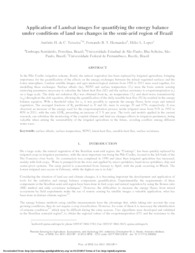Application of Landsat images for quantifying the energy balance under conditions of land use changes in the Semi-Arid region of Brazil.
Application of Landsat images for quantifying the energy balance under conditions of land use changes in the Semi-Arid region of Brazil.
Autoria: TEIXEIRA, A. H. de C.; HERNANDEZ, F. B. T.; LOPES, H. L.
Resumo: In the Nilo Coelho irrigation scheme, Brazil, the natural vegetation has been replaced by irrigated agriculture, bringing importance for the quantification of the effects on the energy exchanges between the mixed vegetated surfaces and the lower atmosphere. Landsat satellite images and agro-meteorological stations from 1992 to 2011 were used together, for modelling these exchanges. Surface albedo (0), NDVI and surface temperature (T0) were the basic remote sensing retrieving parameters necessary to calculate the latent heat flux E) and the surface resistance to evapotranspiration (rs) on a large scale. The daily net radiation (Rn) was obtained from 0, air temperature (Ta) and short-wave transmissivity (sw) throughout the slob equation, allowing the quantification of the daily sensible heat flux (H) by residual in the energy balance equation. With a threshold value for rs, it was possible to separate the energy fluxes from crops and natural vegetation. The averaged fractions of Rn partitioned as H and E, were in average 39 and 67%, respectively. It was observed an increase of the energy used for the evapotranspiration process inside irrigated areas from 51% in 1992 to 80% in 2011, with the ratio E/Rn presenting an increase of 3 % per year. The tools and models applied in the current research, can subsidize the monitoring of the coupled climate and land use changes effects in irrigation perimeters, being valuable when aiming the sustainability of the irrigated agriculture in the future, avoiding conflicts among different water users.
Ano de publicação: 2012
Tipo de publicação: Artigo de periódico
Unidade: Embrapa Semiárido
Observações
1 - Por padrão são exibidas publicações dos últimos 20 anos. Para encontrar publicações mais antigas, configure o filtro ano de publicação, colocando o ano a partir do qual você deseja encontrar publicações. O filtro está na coluna da esquerda na busca acima.
2 - Para ler algumas publicações da Embrapa (apenas as que estão em formato ePub), é necessário ter, no celular ou computador, um desses softwares gratuitos. Sistemas Android: Google Play Livros; IOS: iBooks; Windows e Linux: software Calibre.
Acesse outras publicações
Acesse a Base de Dados da Pesquisa Agropecuária (BDPA) para consultar o acervo completo das bibliotecas da Embrapa.

